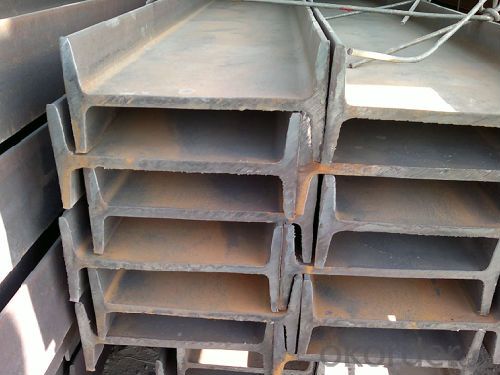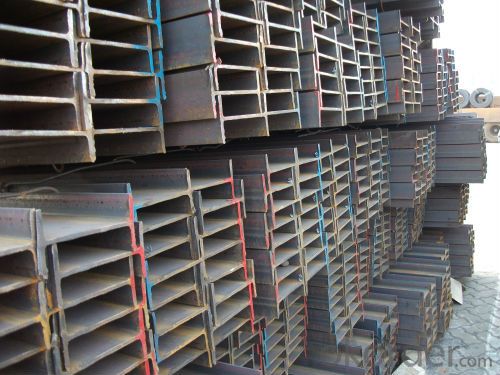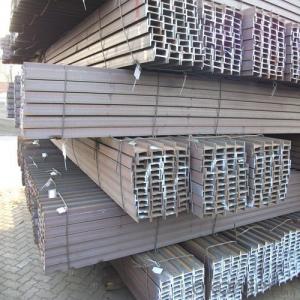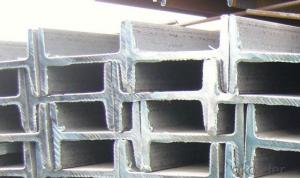Hot Rolled Steel I-Beam IPE IPEAA EN10025 S235JR
- Loading Port:
- Tianjin
- Payment Terms:
- TT or LC
- Min Order Qty:
- 50 m.t.
- Supply Capability:
- 30000 m.t./month
OKorder Service Pledge
OKorder Financial Service
You Might Also Like
Product Description:
OKorder is offeringHot Rolled Steel I-Beam IPE IPEAA EN10025 S235JR at great prices with worldwide shipping. Our supplier is a world-class manufacturer of steel, with our products utilized the world over. OKorder annually supplies products to European, North American and Asian markets. We provide quotations within 24 hours of receiving an inquiry and guarantee competitive prices.
Product Applications:
Hot Rolled Steel I-Beam IPE IPEAA EN10025 S235JR are ideal for structural applications and are widely used in the construction of buildings and bridges, and the manufacturing, petrochemical, and transportation industries.
Product Advantages:
OKorder's Hot Rolled Steel I-Beam IPE IPEAA EN10025 S235JR are durable, strong, and resist corrosion.
Main Product Features:
· Premium quality
· Prompt delivery & seaworthy packing (30 days after receiving deposit)
· Corrosion resistance
· Can be recycled and reused
· Mill test certification
· Professional Service
· Competitive pricing
Product Specifications:
Usage & Applications of Hot Rolled Steel H-beam For Sale
Commercial building structure ;Pre-engineered buildings; Machinery support structure; Prefabricated structure; Medium scale bridges; Ship-building structure.etc.
Packaging & Delivery of Hot Rolled Steel H-beam For Sale
1. Packing: it is nude packed in bundles by steel wire rod
2. Bundle weight: not more than 3.5MT for bulk vessel; less than 3 MT for container load
3. Marks:
Color marking: There will be color marking on both end of the bundle for the cargo delivered by bulk vessel. That makes it easily to distinguish at the destination port.
Tag mark: there will be tag mark tied up on the bundles. The information usually including supplier logo and name, product name, made in China, shipping marks and other information request by the customer.
If loading by container the marking is not needed, but we will prepare it as customer request.
4. Transportation: the goods are delivered by truck from mill to loading port, the maximum quantity can be loaded is around 40MTs by each truck. If the order quantity cannot reach the full truck loaded, the transportation cost per ton will be little higher than full load.
5. Delivered by container or bulk vessel
FAQ:
Q1: Why buy Materials & Equipment from OKorder.com?
A1: All products offered byOKorder.com are carefully selected from China's most reliable manufacturing enterprises. Through its ISO certifications, OKorder.com adheres to the highest standards and a commitment to supply chain safety and customer satisfaction.
Q2: How do we guarantee the quality of our products?
A2: We have established an advanced quality management system which conducts strict quality tests at every step, from raw materials to the final product. At the same time, we provide extensive follow-up service assurances as required.
Q3: How soon can we receive the product after purchase?
A3: Within three days of placing an order, we will begin production. The specific shipping date is dependent upon international and government factors, but is typically 7 to 10 workdays.
Q4: What makes stainless steel stainless?
A4: Stainless steel must contain at least 10.5 % chromium. It is this element that reacts with the oxygen in the air to form a complex chrome-oxide surface layer that is invisible but strong enough to prevent further oxygen from "staining" (rusting) the surface. Higher levels of chromium and the addition of other alloying elements such as nickel and molybdenum enhance this surface layer and improve the corrosion resistance of the stainless material.
Q5: Can stainless steel rust?
A5: Stainless does not "rust" as you think of regular steel rusting with a red oxide on the surface that flakes off. If you see red rust it is probably due to some iron particles that have contaminated the surface of the stainless steel and it is these iron particles that are rusting. Look at the source of the rusting and see if you can remove it from the surface.
Images:


- Q:Can steel I-beams be used for cantilevered structures?
- Yes, steel I-beams can be used for cantilevered structures. Cantilevered structures are those that extend horizontally from a support point with no additional supports along the length. Steel I-beams are commonly used in the construction industry due to their high strength and durability. They are designed to withstand heavy loads and provide structural stability, making them suitable for cantilevered structures. The I-beam's shape allows it to distribute the load evenly, preventing excessive stress concentration at the connection point. Additionally, steel I-beams can be fabricated to various lengths and sizes, providing flexibility in designing and constructing cantilevered structures for different applications.
- Q:What are the different types of steel I-beam support systems?
- There are several types of steel I-beam support systems, including rolled or wide-flange beams, welded or built-up beams, and composite beams. Additionally, there are different variations and configurations of these support systems depending on the specific application and structural requirements.
- Q:What are the different methods of welding steel I-beams?
- There are several different methods of welding steel I-beams, each with its own advantages and applications. Some of the most common methods include: 1. Shielded Metal Arc Welding (SMAW): Also known as stick welding, SMAW is a versatile and widely used method for welding I-beams. It involves using a consumable electrode coated in flux, which provides a shielding gas to protect the weld from atmospheric contamination. 2. Gas Metal Arc Welding (GMAW): This method, also known as MIG welding, uses a continuous solid wire electrode and a shielding gas to protect the weld from oxidation. GMAW is known for its high welding speed and ease of use, making it suitable for I-beams with thicker sections. 3. Flux-Cored Arc Welding (FCAW): FCAW is similar to GMAW, but instead of a solid wire electrode, it uses a tubular electrode filled with flux. This flux provides a shielding gas and allows for greater weld penetration, making it suitable for thicker I-beams and outdoor welding applications. 4. Submerged Arc Welding (SAW): SAW involves feeding a continuous wire electrode into a weld joint while covering it with a layer of granular flux. The weld is formed beneath a layer of flux, which helps protect it from atmospheric contamination and provides excellent penetration. SAW is commonly used for welding heavy I-beams and large structural components. 5. Laser Beam Welding (LBW): This method uses a high-energy laser beam to melt and fuse the I-beam surfaces together. LBW offers precise control, minimal heat input, and high welding speeds, making it suitable for thin I-beams and applications requiring high-quality welds. 6. Electron Beam Welding (EBW): EBW utilizes a highly concentrated beam of electrons to melt and join the I-beam surfaces together. It is commonly used for high-precision applications and can produce deep, narrow welds with minimal distortion. Each welding method has its own advantages and limitations, so the choice of method depends on factors such as the thickness of the I-beam, the desired weld quality, the welding environment, and the equipment available. It is important to select the appropriate method and ensure proper training and safety precautions are followed to achieve strong and reliable welds on steel I-beams.
- Q:How do engineers determine the appropriate size and type of steel I-beam for a project?
- Engineers determine the appropriate size and type of steel I-beam for a project by considering various factors such as the load requirements, span length, and structural design. They analyze the expected loads and forces that the beam will experience, including dead loads (weight of the structure itself), live loads (occupancy and usage), and environmental loads (wind, seismic activity). By performing calculations and simulations, engineers can determine the maximum bending moment, shear force, and deflection the beam will endure. They then refer to structural design codes and standards, such as the American Institute of Steel Construction (AISC) Manual, to select a suitable size and type of steel I-beam that can safely support the anticipated loads while meeting the desired structural performance.
- Q:How do steel I-beams contribute to the overall flexibility of a structure?
- There are several ways in which steel I-beams enhance the flexibility of a structure. Firstly, their distinctive shape and design enable improved weight distribution and load-bearing capacity. The flanges of the I-beam, which are the horizontal sections at the top and bottom, offer resistance against bending forces, while the web, the vertical section connecting the flanges, helps distribute the load evenly. This design permits the I-beam to support heavy loads without sagging or buckling. Moreover, steel I-beams possess a high strength-to-weight ratio, allowing them to endure substantial loads while remaining relatively lightweight. This feature empowers architects and engineers to design structures that are more flexible and versatile, as the I-beams can support heavy loads without the need for excessive amounts of material. Additionally, the lightweight nature of steel I-beams simplifies their transportation and installation, thereby adding to the flexibility of the construction process. Another manner in which steel I-beams enhance the flexibility of a structure is their capacity to span long distances without requiring intermediate supports. This attribute proves particularly advantageous in open floor plans or large industrial spaces where uninterrupted space is desired. The ability of steel I-beams to span long distances eliminates the need for additional columns or walls, thus offering greater flexibility in terms of the structure's layout and functionality. Lastly, steel I-beams exhibit high durability and resistance to various environmental factors, such as fire, moisture, and pests. This durability ensures that the structure remains flexible and reliable over time, withstanding potential damage or wear and tear. The long lifespan of steel I-beams contributes to the overall flexibility of a structure by reducing the need for frequent repairs or replacements, thus offering long-term flexibility in terms of maintenance and cost-effectiveness. In conclusion, steel I-beams enhance the overall flexibility of a structure through their unique design, high strength-to-weight ratio, capacity to span long distances, and durability. These characteristics enable better weight distribution, versatility in design, and long-term reliability, making steel I-beams a vital component in the creation of flexible and adaptable structures.
- Q:How are steel I-beams used in multi-story buildings?
- Steel I-beams are commonly utilized in multi-story buildings as essential structural components that offer support and stability. These beams are typically constructed from steel due to its exceptional strength and durability. I-beams are specifically designed to bear heavy loads and evenly distribute the weight across the entire structure. They are frequently employed as horizontal beams, known as floor joists, to uphold the weight of the floors as well as any additional loads such as furniture, equipment, and people. Apart from their role in supporting the floors, steel I-beams are also utilized as vertical columns or beams to provide vertical support for the entire building. These columns aid in transferring the weight of the upper floors downwards to the foundation, thereby guaranteeing the stability and integrity of the structure. The utilization of steel I-beams in multi-story buildings offers numerous advantages due to their impressive strength-to-weight ratio. This means they can effectively support heavy loads without being excessively bulky or cumbersome. Consequently, this allows for a more efficient utilization of space and enables architects and engineers to design taller and more spacious buildings. In addition, steel I-beams possess fire-resistant properties, which is of utmost importance for the safety of occupants in the event of a fire. They exhibit superior resistance to high temperatures for an extended period when compared to other building materials, thereby minimizing the risk of structural collapse. In summary, steel I-beams fulfill a critical role in multi-story buildings by providing structural support, distributing loads, ensuring stability, and enhancing the safety and longevity of the structure.
- Q:Can steel I-beams be used in industrial facilities?
- Yes, steel I-beams are commonly used in industrial facilities for their strength, durability, and load-bearing capabilities. They provide structural support for overhead cranes, mezzanines, platforms, and heavy equipment, making them a reliable choice for industrial construction.
- Q:Can steel I-beams be used for bridge construction?
- Indeed, bridge construction can indeed incorporate steel I-beams. Thanks to their exceptional strength and durability, steel I-beams are frequently utilized in this field. They possess remarkable load-bearing capabilities, rendering them appropriate for supporting heavy loads like vehicles and pedestrians. Moreover, steel I-beams exhibit resistance to corrosion and can endure harsh weather conditions, which renders them ideal for constructing bridges that must withstand diverse environmental factors. The adaptability of steel I-beams empowers engineers to fashion bridges of varying spans and shapes, thereby making them a favored option in contemporary bridge construction. Ultimately, steel I-beams emerge as a dependable and effective choice for bridge construction.
- Q:Can steel I-beams be used for renewable energy projects?
- Yes, steel I-beams can be used for renewable energy projects. These beams are commonly used in the construction of various renewable energy structures such as wind turbines, solar panel installations, and hydroelectric power plants. They provide structural support and stability to these projects, ensuring their longevity and efficiency.
- Q:How do steel I-beams contribute to the overall cost-effectiveness of a construction project?
- Steel I-beams contribute to the overall cost-effectiveness of a construction project in several ways. Firstly, they are incredibly strong and durable, which allows for the construction of structures that can withstand heavy loads and harsh weather conditions. This means that fewer beams are needed to support the same weight compared to other materials, resulting in cost savings on materials and labor. Additionally, steel I-beams are highly versatile and can be easily fabricated and customized to meet specific project requirements. They can be cut, welded, and shaped to fit different designs and structural needs, which reduces wastage and eliminates the need for excessive on-site modifications. This adaptability also allows for faster construction, minimizing labor costs and project timelines. Furthermore, steel I-beams have a long lifespan and require minimal maintenance compared to other materials. They are highly resistant to corrosion, pests, and fire, which reduces the need for regular repairs and replacements. This longevity translates into long-term cost savings for the project owner, as there is less expenditure on maintenance and replacement over the life cycle of the structure. Lastly, steel I-beams are readily available and sourced from various suppliers, making them a cost-effective choice for construction projects. The competitive market for steel materials ensures reasonable pricing and access to a wide range of options, allowing project managers to choose the most cost-efficient solution that meets their quality requirements. In conclusion, the use of steel I-beams in construction projects enhances cost-effectiveness by reducing material and labor costs, enabling faster construction, minimizing maintenance needs, and offering a wide range of affordable options.
1. Manufacturer Overview |
|
|---|---|
| Location | |
| Year Established | |
| Annual Output Value | |
| Main Markets | |
| Company Certifications | |
2. Manufacturer Certificates |
|
|---|---|
| a) Certification Name | |
| Range | |
| Reference | |
| Validity Period | |
3. Manufacturer Capability |
|
|---|---|
| a)Trade Capacity | |
| Nearest Port | |
| Export Percentage | |
| No.of Employees in Trade Department | |
| Language Spoken: | |
| b)Factory Information | |
| Factory Size: | |
| No. of Production Lines | |
| Contract Manufacturing | |
| Product Price Range | |
Send your message to us
Hot Rolled Steel I-Beam IPE IPEAA EN10025 S235JR
- Loading Port:
- Tianjin
- Payment Terms:
- TT or LC
- Min Order Qty:
- 50 m.t.
- Supply Capability:
- 30000 m.t./month
OKorder Service Pledge
OKorder Financial Service
Similar products
New products
Hot products
Related keywords




























